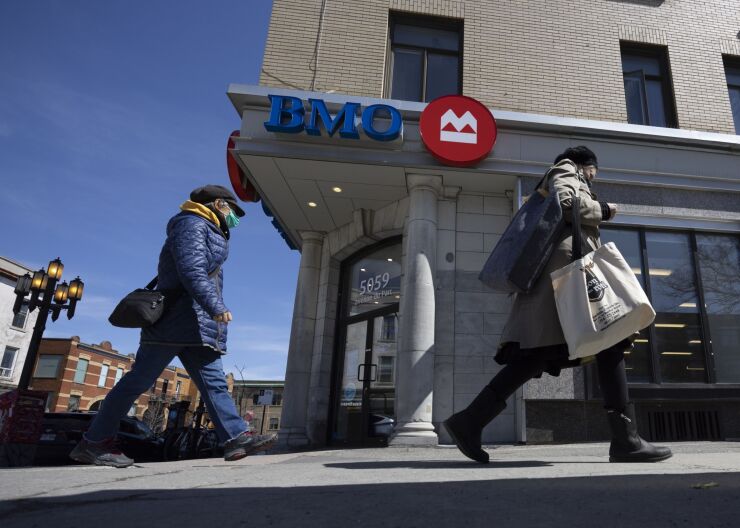
UPDATE: This article includes information from the bank's third-quarter earnings call and comments from an analyst note.
BMO Financial Group socked away higher-than-expected provisions for potential loan losses in the third quarter, dragging down earnings, while its Canadian business offered some revenue relief.
The Toronto-based bank said Tuesday that provisions for credit losses nearly doubled last quarter from the year-ago period, hitting 906 million Canadian dollars. Net income for the latest quarter, which ended July 31, was up at CA$1.87 billion from CA$1.56 billion a year ago, buttressed by BMO's consumer and commercial banking in Canada.
CEO Darryl White said BMO hasn't yet topped out on credit costs, which also hampered earnings last quarter.
Jefferies analyst John Aiken downgraded BMO from "buy" to "hold" on Tuesday, writing in a note that BMO disappointed for a third consecutive quarter as credit once again "[reared] its ugly head." The bank's stock was recently down nearly 6%, trading at $83.64 on the New York Stock Exchange.
"We freely admit that we may be closing the barn door after the animals have escaped, the pace of deterioration in credit and BMO's relative over-exposure to commercial infer ongoing pressure to the bank's earnings," Aiken said. "While we remain positive on the longer-term outlook for its U.S. operations, near-term outperformance over our forecast period has become increasingly difficult."
BMO expects provisions for at-risk loans to continue putting pressure on profit for the rest of the year, but Chief Risk Officer Piyush Agrawal said on a call with analysts that the costs aren't indicative of underlying issues with the bank's underwriting.
"We're not anticipating any radical changes to risk appetite, but always making refinements," Agrawal said. "That's what good risk managers and bankers do to ensure we're capturing the evolving risks in the industry. … There isn't an industry theme, there isn't a geography theme. These are very episodic."
BMO said its growth strategy isn't sparking higher losses, even as it's broken into specialty segments in the U.S., like sponsor fund lending, dealer finance and asset-based lending.
White said the bank's rising provisions are "effectively the delayed consequence of the dynamics that were pretty unique to a pandemic." He added that the economy is showing signs of an inflection point, which would position the bank to grow profitable market share.
The Bank of Canada has cut interest rates twice this summer in an effort to cool high inflation, and Federal Reserve
BMO's earnings per share of CA$2.48 missed analyst expectations of CA$2.61 a share, according to S&P Capital IQ. The bank's revenue of CA$8.19 billion was up 1.7% from the year prior, boosted by higher balances and margins in its Canadian retail and commercial business, which saw a 7% year-over-year increase in revenue.
In the U.S., the CA$1.4 trillion-asset bank is feeling the strain from high interest rates and inflation as it seeks to take advantage of its 2023 acquisition of Bank of the West. The deal, one of the largest that closed last year, allowed the Canadian company to expand its footprint in California and helped it plant a flag in Colorado, New Mexico and Oregon.
"We're seeing really good momentum in our Western markets, fueled by above-targeted brand awareness and consideration in the market that's generating strong core deposit, checking and savings growth," said Erminia "Ernie" Johannson, BMO's group head for North American personal and commercial banking, on the earnings call. "It's picking up momentum. And as [White] said, as the market becomes more invigorated, we're going to see that acceleration just continue."

Net income for the U.S. personal and commercial business declined 9%
Among Canadian banks, the fight to win business south of the border has been a costly strategy but can offer big returns. TD Bank Group had emphasized its ambitious U.S. growth plans in prior years but recently hit a snag as it deals with the fallout of a massive anti-money-laundering failure. The Toronto bank may have to pay more than $3 billion in fines to American regulators, plus face nonmonetary penalties that could hamper expansion.
Even Bank of Nova Scotia, which has
Growth at BMO —
"We see risk/reward as attractive given the lowered expectations and what we view as a differentiated franchise, potential for lower U.S. rates to alleviate funding cost pressures and stabilizing credit outlook," Poonawala said in the note.





